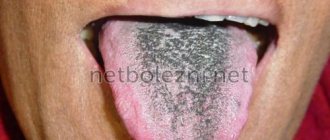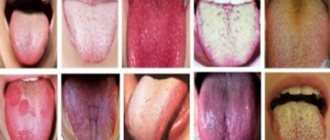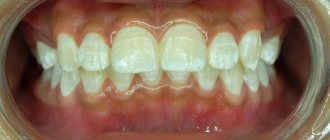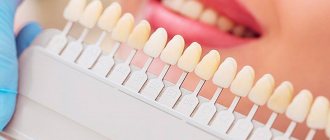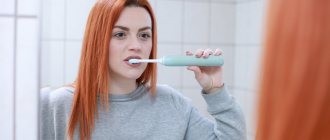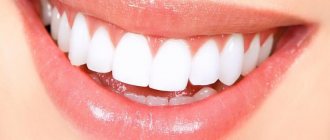In most cases, dental plaque is the cause of insufficient oral hygiene. But it also happens that people who are very sensitive to hygiene issues develop black plaque on their teeth.
The reasons for its appearance in adults and children differ : if in the former it is a consequence of drinking large amounts of tea and coffee, as well as smoking, then in the latter it may be associated with the activity of certain bacteria, the use of mouthwashes and the use of chewable vitamins.
Types of plaque
Plaque on teeth is divided into two large groups:
- the occurrence of which is associated with external contamination of the tooth;
- appearing due to the deposition of pigments.
If oral hygiene is not maintained, plaque may appear on the teeth:
- soft microbial;
- mineralized;
- hard, often called tartar.
If everything is in order with hygiene, then black plaque is a consequence of:
- regular consumption of tea, coffee and nicotine;
- use of medications with high iron content;
- vital activity of chromogenic bacteria;
- use of certain types of rinses and antiseptics.
Bacterial plaque on teeth: causes
Soft or, as it is also called, bacterial plaque has a soft consistency, so it is easy to get rid of it with the help of an ordinary toothbrush. The main place of its accumulation is the neck of the teeth.
Harder plaque that cannot be removed with a brush is called tartar. It occurs during the mineralization of soft plaque with phosphorus and calcium salts present in saliva.
Why does plaque form?
There are constantly a huge number of bacteria in the mouth, which, firstly , multiply, and secondly , leave behind waste products. Even if you brush your teeth regularly, plaque cannot be avoided: within 6 hours after thorough brushing, you can easily notice, without resorting to the use of specialized equipment, a bacterial mass on the surface of the tooth enamel. A surge in microbial activity is observed immediately after eating: leftover food in the mouth forces bacteria to begin intensive processing.
At the same time, even small pieces of food that are invisible to the human eye are enough for microorganisms: they can feed on a film consisting of carbohydrates and proteins that invariably remains on the surface of the teeth after eating, and on food debris that gets into the spaces between the teeth. In this regard, it is imperative to brush your teeth for 15 minutes after each meal, since the mass of bacterial plaque can increase several times in volume in 1-2 hours. Plaque accumulates especially intensely on the necks of teeth in people who like to snack on a bun or something sweet between main meals.
Almost immediately after the soft plaque appears, the process of mineralization begins, as a result of which it gradually hardens. The period of primary mineralization (i.e., when the plaque, in simple terms, “sets” but still remains loose) is 10-15 hours. When the plaque finally hardens, its surface becomes ideal for the formation of deposits.
Laser cleaning
This is an innovative, gentle and painless method of cleaning teeth from plaque of any color (black, yellow, etc.). During the procedure, the enamel is not damaged, and there is virtually no gum bleeding. Although this method of dealing with deposits is expensive, the investment is completely justified.
Benefits of laser teeth cleaning:
- removal of plaque and tartar, regardless of location;
- low level of pain, and therefore local anesthesia is not required;
- the ability to regulate the intensity of the impact;
- absence of noise and vibration, which is important for patients with dental phobia;
- non-contact - the device does not come into contact with tissues;
- safety of the procedure - the formation of enamel microcracks is excluded;
- no gum bleeding - even if tissue is damaged, the blood immediately coagulates under the influence of the laser;
- minimal risk of complications - the beam has a disinfecting effect, so during the procedure all pathogenic microorganisms are killed;
- rapid tissue restoration - due to stimulation of trophism and reparative processes;
- lightening the enamel by 1-3 tones;
- long-term effect - no plaque on the teeth for a year, provided proper care of the teeth and the oral cavity.
Laser deposit removal can only be performed by adults (over 18 years of age). It is not given to pregnant and lactating women if the patient has inflammation of the oral mucosa, severe heart pathologies or infectious diseases. Also contraindications are AIDS, HIV, bronchial asthma, chronic bronchitis.
Pigmented dark plaque on teeth
The main reason for the appearance of such plaque in adults is smoking, drinking coffee and tea. Maintaining hygiene guarantees the absence of bacterial plaque and tartar, but if you neglect it, black plaque will not take long to appear. Pigments adhere very well to enamel covered with bacterial plaque formed as a result of infrequent brushing of teeth.
Types of pigment plaque include:
- brown coating that occurs from regular consumption of tea and coffee in large quantities;
- accumulation of nicotine deposits;
- darkening of the enamel as a result of taking medications containing iron;
- proliferation of bacteria that form dyes (they are called chromogenic);
- change in enamel color after using antibiotics;
- blackening due to diseases of internal organs.
If plaque is caused by bacterial factors, then regular thorough brushing of teeth, the use of rinses and floss reduce the likelihood of its occurrence to a minimum. However, if the reason for the appearance of plaque lies in the influence of dyes, maintaining hygiene to prevent it will not help.
Black plaque on children's teeth , the causes of which are associated with the activity of chromogenic anaerobic bacteria, appears in the form of spots localized in the neck area. Actinomycete bacteria produce hydrogen sulfite, which reacts with iron (found in saliva and red blood cells). As a result, a form of black iron that cannot be cleaned off with a regular brush is deposited on the surface of the teeth. Chromogenic coloration can also be orange, green and brown.
Black plaque on a child’s teeth can also form for other reasons . It appears due to:
- the use of antiseptics that contain chlorhexidine, benzaclonium chloride, as well as essential oils (the latter are found in the popular Listerine product);
- consumption of foods rich in iron, as well as vitamins with a high content of iron.
Folk remedies
Fans of traditional medicine and those who categorically do not want to go to the doctor can use “long-proven” methods of cleansing teeth from smoker’s plaque.
Important. The author of the article consulted with dental hygienists, and moreover, looked at several forums with reviews. It's up to you to decide, but some people need to step on their own rake.
So:
Soda is a favorite among smokers. Apply baking soda to a wet toothbrush and rub your teeth with it. A small effect is noticeable with a slight plaque; fossilized deposits cannot be processed. With frequent use, it threatens to thin the enamel.
Tooth powder is for amateurs. The viscous mass removes plaque and refreshes the oral cavity. Not everyone enjoys the process of brushing their teeth.
Fruit acids - you can use lemon slices, strawberries, green apples. Rub your teeth with them and rinse your mouth well. Good for freshening the mouth.
Tea tree oil - after brushing your teeth, apply a few drops of oil to the brush and rub the enamel with it. Rinse with water and lemon juice. There may be slight numbness in the gums.
Wood ash is often recommended, but suddenly you come across a pebble... In this case, it’s better to try activated carbon from the pharmacy. In any case, there is no risk of breaking teeth.
Hydrogen peroxide - applied to a cotton pad and rubbed onto the enamel. The gums must be protected. From reviews: with frequent use, the enamel becomes loose and dark, such a contradiction.
Over the past few years, smokers have come to the conclusion that it is easier and more effective to visit a dentist.
How to remove plaque from teeth on your own
Many people do not like to visit the dentist again, especially when it comes to removing plaque, which does not cause much inconvenience. The reasons for this are clear: lack of free time and reluctance to pay for the procedure.
You can try to remove plaque from your teeth at home, but this will only work if there are no subgingival deposits and the plaque layer is thin.
The first method involves using a special toothpaste to remove plaque with abrasive substances. The label of such pastes must indicate the RDA indicator, indicating the degree of abrasiveness. In pastes that eliminate plaque, its value should exceed 100. But such pastes cannot be used on an ongoing basis. If the paste contains pyrophosphates, then it can help get rid of tartar, since they have the ability to dissolve its matrix.
The most effective of these pastes are:
- President White Plus. The abrasiveness index is 200 units; in addition, the composition contains silicon dioxide, which has abrasive and polishing properties. You should not use the paste more than once a week.
- Lacalut White. According to the abrasiveness index (RDA=120), it is more gentle than the previous sample. The composition contains pyrophosphates, which make the plaque loose.
The second method is to use a special toothbrush, which allows you to remove plaque yourself. Recommended use:
Ultrasonic cleaning with the “Vector” device
The German “Vector” system was created specifically to rid teeth of plaque. It effectively removes soft and hard mineralized deposits on the coronal part of units, as well as in periodontal pockets. The peculiarity of the procedure is the use of a special nozzle; ultrasound is applied strictly vertically (top to bottom and bottom to top). This allows you to remove deposits carefully, comfortably and painlessly. The entire process is controlled and predictable; during the procedure, the dentist adjusts the amplitude of the waves.
Thanks to the use of a special solution with hydroxyapatite granules, high-quality polishing of the surface of the crown and root occurs; after such cleaning, the appearance of new plaque occurs several times slower. In addition, the liquid promotes rapid regeneration of inflamed tissues, reduces sensitivity during the procedure and makes breathing fresh.
Plaque removal using the Vector device can be carried out when:
- gingivitis;
- periodontitis;
- identifying periodontal pockets 4-6 mm deep;
- increased sensitivity of teeth and gums;
- atrophic processes, exposure of the necks of units.
The procedure is contraindicated in childhood, during pregnancy and lactation, in the case of deep periodontal pockets filled with pus. Also, cleaning is not carried out if there is severe mobility of the units, the presence of malignant tumors in the body, severe heart disease, or if there is a pacemaker.
After the procedure, the doctor recommends using a new soft brush and toothpaste for sensitive teeth. In addition, you should give up coloring foods and drinks and smoking for 2-3 days.
Plaque on a child’s teeth: treatment
Removing bacterial and chromogenic plaque in a child will be no different from a similar procedure recommended for an adult: ultrasonic cleaning and AirFlow are used in the same way.
However, chromogenic staining of teeth may return over time. The only possible solution to the problem is regular professional cleaning by a dentist. To make visits to the dentist as rare as possible, your child should be taught to use an electric toothbrush, the pulsating circular movements of the head of which perfectly break up plaque.
Accelerated formation of deposits is promoted by blood in the oral cavity, so the child’s gingivitis must be treated. The use of chlorhexidine and antiseptics based on it should be abandoned.
Smoking and implantation
Unfortunately, such concepts as smoking and dental implants are practically incompatible. Patients who smoke are much more likely to experience implant failure , especially if they smoke during osseointegration.
Smoking several months before the procedure is no less harmful. Much the same can be said about prosthetics – it is much more difficult for smoking patients to adapt to wearing prostheses, and they often experience complications and side effects.
IMPORTANT: Unfortunately, concepts such as smoking and dental implants are practically incompatible. Patients who smoke are much more likely to experience implant failure, especially if they smoke during osseointegration.
